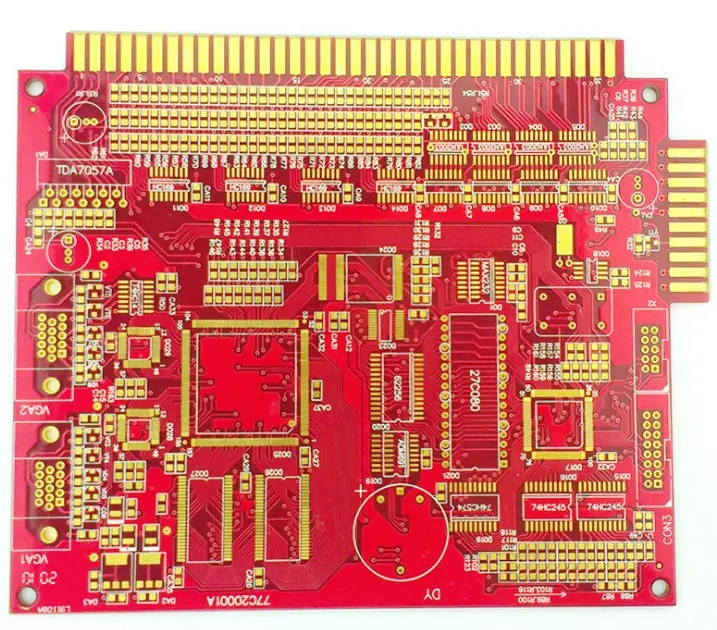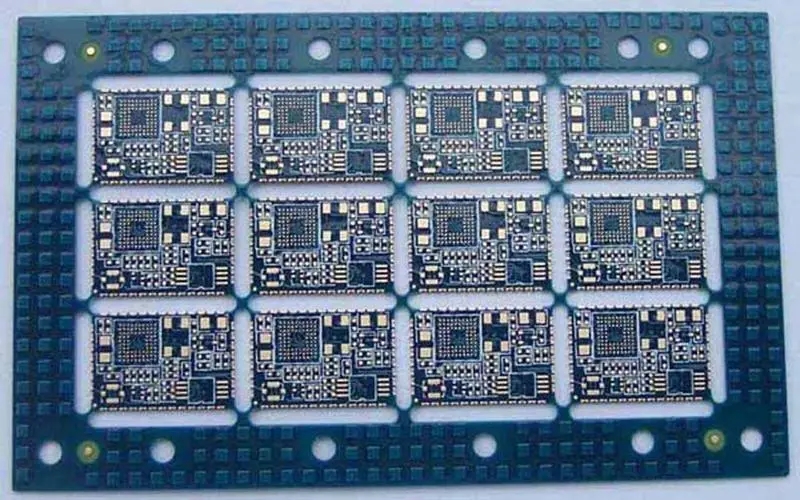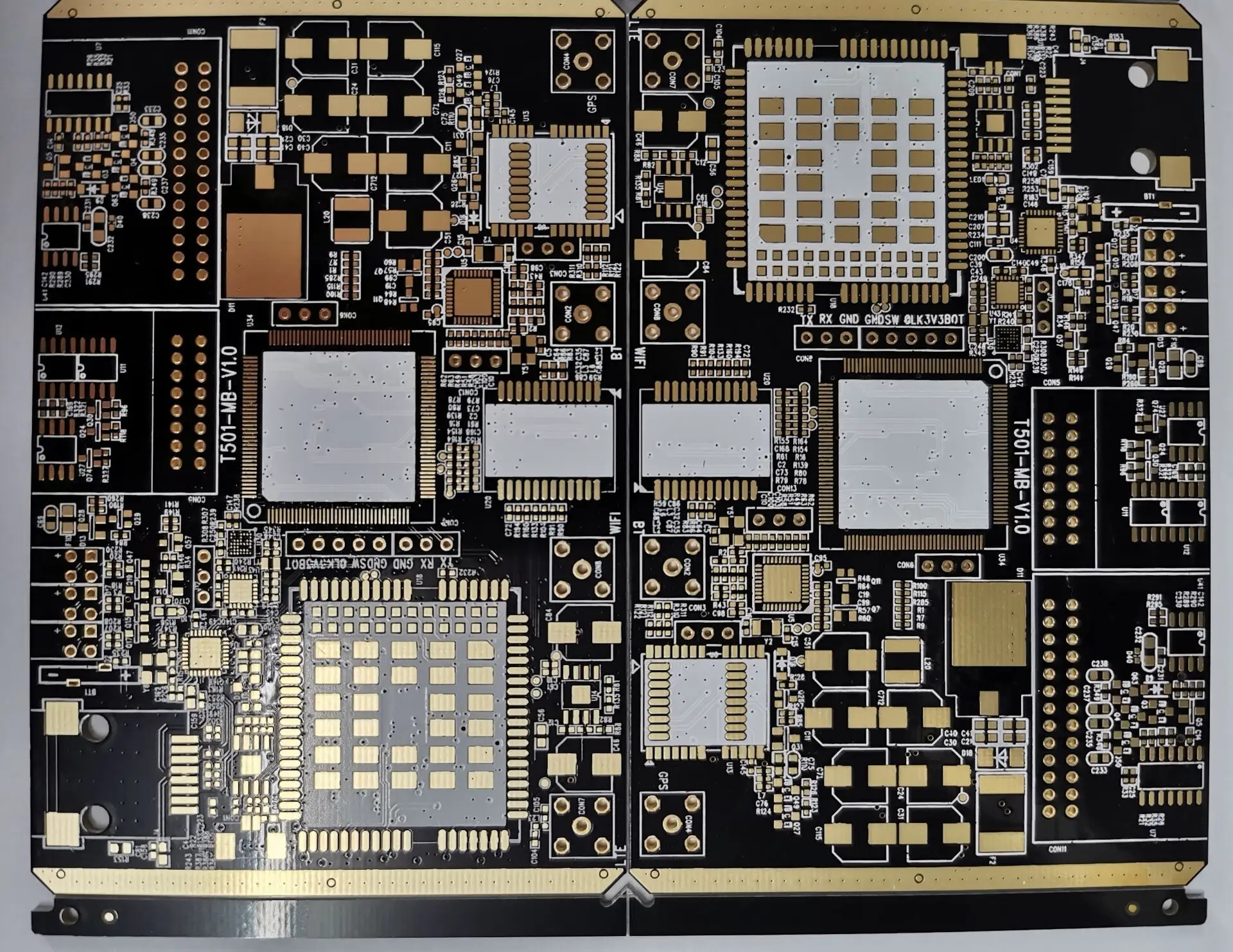
PCB manufacturers explain the wiring principles of PCB
1. General rules
1.1 Digital, analog and DAA (data access arrangement) signal wiring areas are pre divided on PCB.
1.2 Digital and analog components and corresponding wiring shall be separated as far as possible and placed in their respective wiring areas.
1.3 The high-speed digital signal wiring shall be as short as possible.
1.4 The sensitive analog signal wiring shall be as short as possible.
1.5 Reasonably distribute power and ground.
1.6 DGND, AGND and field separation.
1.7 Wide wires shall be used for power supply and critical signal wiring.
1.8 The digital circuit is placed near the parallel bus/serial DTE interface, and the DAA circuit is placed near the telephone line interface.
2. Component placement
2.1 In the system circuit schematic diagram:
a) Divide digital, analog, DAA circuits and related circuits;
b) Divide digital, analog and mixed digital/analog components in each circuit;
c) Pay attention to the positioning of power supply and signal pins of each IC chip.
2.2 The wiring area of digital, analog and DAA circuits on the PCB board is preliminarily divided (generally 2/1/1), and the digital, analog components and their corresponding wiring are as far away from and limited in their respective wiring areas as possible.
Note: When DAA circuit accounts for a large proportion, there will be more control/status signal wiring going through its wiring area, which can be adjusted according to local rules, such as component spacing, high voltage suppression, current limitation, etc. www.pcbdown.cn
2.3 After preliminary division, place components from Connector and Jack:
a) The location of plug-ins shall be reserved around the connector and jack;
b) Space for power supply and ground wiring shall be reserved around components;
c) The location of corresponding plug-ins shall be reserved around the socket.
2.4 First place hybrid components (such as Modem devices, A/D, D/A conversion chips, etc.):
a) Determine the placement direction of components, and try to make the digital signal and analog signal pins face the respective wiring area;
b) Place components at the junction of digital and analog signal wiring areas.
2.5 Place all simulators:
a) Place analog circuit components, including DAA circuit;
b) Simulators are close to each other and placed on the PCB side containing TXA1, TXA2, RIN, VC, VREF signal wiring;
c) Avoid placing high noise components around TXA1, TXA2, RIN, VC, VREF signal wiring;
d) For serial DTE modules, DTE EIA/TIA-232-E
The receiver/driver of serial interface signals shall be as close to the connector as possible and far away from the high frequency clock signal wiring to reduce/avoid the added noise suppression devices on each line, such as choke coils and capacitors.
2.6 Placing digital components and decoupling capacitors:
a) The digital components are placed in a centralized manner to reduce the wiring length;
b) Place a 0.1uF decoupling capacitor between the power supply/ground of the IC, and keep the connection wires as short as possible to reduce EMI;
c) For parallel bus module, components are close to each other
The connector is placed on the edge to meet the application bus interface standard, for example, the ISA bus routing length is limited to 2.5 inches;
d) For the serial DTE module, the interface circuit is close to the connector;
e) The crystal oscillator circuit shall be as close to its driver as possible.
2.7 The ground wires of each area are usually connected at one or more points with 0 Ohm resistors or beans.
3. Signal wiring
3.1 In the modem signal wiring, the signal lines that are easy to generate noise and the signal lines that are easy to be interfered shall be as far away as possible. If it is unavoidable, neutral signal lines shall be used for isolation.
The signal pin, neutral signal pin and signal pin vulnerable to interference of Modem are shown in the following table:
3.2 The digital signal wiring shall be placed in the digital signal wiring area as far as possible;
The analog signal wiring shall be placed in the analog signal wiring area as far as possible;
(The isolated wiring can be placed in advance to limit it, so as to prevent wiring from going out of the wiring area)
Digital signal wiring is perpendicular to analog signal wiring to reduce cross coupling.

3.3 Use isolated wiring (usually ground) to limit analog signal wiring to analog signal wiring area.
a) The isolated grounding wire of the analog area surrounds the analog signal wiring area and is laid on both sides of the PCB board, with a line width of 50-100ml;
b) The isolated ground wire of digital area shall be laid around the digital signal wiring area on both sides of the PCB board, with a line width of 50-100 mil, and 200 mil shall be laid on one side of the PCB board.
3.4 The wiring width of parallel bus interface signal is>10mil (generally 12-15mil), such as/HCS,/HRD,/HWT,/RESET.
3.5 Analog signal wiring width>10mil (generally 12-15mil), such as MICM, MICV, SPKV, VC, VREF, TXA1, TXA2, RXA, TELIN, TELOUT.
3.6 All other signal wiring shall be as wide as possible, with the wiring width>5mil (generally 10mil), and the wiring between components shall be as short as possible (it shall be considered in advance when placing components).
3.7 The wiring width from the bypass capacitor to the corresponding IC is more than 25mil, and the use of vias should be avoided as far as possible.
3.8 Signal lines passing through different areas (such as typical low-speed control/status signals) shall pass through isolated ground wires at one point (preferred) or two points. If the routing is only on one side, the isolation ground wire can go to the other side of the PCB to skip the signal routing and keep continuous.
3.9 High frequency signal wiring shall avoid 90 degree angle bending, and smooth arc or 45 degree angle shall be used.
3.10 High frequency signal wiring shall reduce the use of via connection.
3.11 All signal wiring shall be far away from crystal oscillator circuit.
3.12 High frequency signal wiring shall adopt single continuous wiring to avoid several sections of wiring extending from one point.
3.13 In the DAA circuit, at least 60 mils of space shall be reserved around the perforation (all layers).
3.14 Clear the ground loop to prevent accidental current feedback from affecting the power supply.
4. Power supply
tteedf4636!@#$%
4.1 Determine the power connection relationship.
4.2 In the digital signal wiring area, use 10uF electrolytic capacitor or tantalum capacitor and 0.1uF ceramic chip capacitor in parallel and then connect them to the power supply/ground. Place one at the power inlet and the farthest end of the PCB to prevent noise interference caused by power spikes.
4.3 For double-sided boards, in the same layer of the electric circuit, surround the circuit with power supply wiring with a width of 200 mil on both sides. (The other side must be digitally treated in the same way)
4.4 Generally, the power cable shall be laid first, and then the signal cable shall be laid.
5. Ground
5.1 In the double-sided board, the unused areas around and below the digital and analog components (except DAA) are filled with digital ground or analog region, the same region at each layer is connected together, and the same region at different layers is connected through multiple vias: Modem DGND pin is connected to the digital ground area, and AGND pin is connected to the analog ground area; The digital and analog regions are separated by a straight gap.
5.2 In the four layer board, digital and analog components (except DAA) are covered by digital and analog regions; Modem DGND pin is connected to digital ground area, and AGND pin is connected to analog ground area; The digital and analog regions are separated by a straight gap.
5.3 If an EMI filter is required in the design, a certain space shall be reserved at the interface socket end, and most EMI devices (Bead/capacitors) can be placed in this area; The unused area shall be filled with land, and the shielding shell, if any, shall also be connected with it.
5.4 The power supply of each functional module shall be separated. The functional modules can be divided into: parallel bus interface, display, digital circuit (SRAM, EPROM, Modem) and DAA, etc. The power/ground of each functional module can only be connected at the source point of the power/ground.
5.5 For the serial DTE module, the decoupling capacitor is used to reduce the power coupling, and the same can be done for the telephone line.
5.6 The ground wire is connected through a point. If possible, use Bead; If it is necessary to suppress EMI, ground wires are allowed to be connected at other places.
5.7 All ground wires shall be laid as wide as possible, 25-50 mil.
5.8 Capacitor wiring between all IC power/ground shall be as short as possible, and via shall not be used.
6. Crystal oscillator circuit
6.1 All wiring connected to crystal input/output terminals (such as XTLI and XTLO) shall be as short as possible to reduce noise interference and influence of distributed capacitance on Crystal. XTLO routing shall be as short as possible, and the bending angle shall not be less than 45 degrees. (Because XTLO is connected to the driver with fast rise time and high current)
6.2 There is no ground wire layer in the double-sided board. The capacitance ground wire of the crystal oscillator shall be connected to the DGND pin closest to the crystal oscillator on the device with as wide a short wire as possible, and the through-hole shall be minimized.
6.3 If possible, the crystal case shall be grounded.
6.4 Connect a 100 Ohm resistor between XTLO pin and crystal oscillator/capacitor node.
6.5 The ground of the crystal oscillator capacitor is directly connected to the GND pin of the Modem. Do not use the ground area or ground wire routing to connect the capacitor and the GND pin of the Modem.
7. Independent Modem design using EIA/TIA-232 interface
7.1 Use metal shell. If it is necessary to use plastic shell, metal foil or conductive material shall be pasted inside to reduce EMI.
7.2 Place the same mode of Choke on each power cord. tteedf4636!@#$%
7.3 The components shall be placed together and close to the connector of EIA/TIA-232 interface.
7.4 All EIA/TIA-232 devices are separately connected to the power/ground from the power source point. The source point of the power/ground shall be the power input terminal on the board or the output terminal of the voltage regulating chip.
7.5 EIA/TIA-232 cable signal grounding is connected to digital grounding.
For analog signals, further details are given:
The design of analog circuits is the most troublesome and fatal part for engineers. Although the development of digital circuits and large-scale integrated circuits is very rapid, the design of analog circuits is still inevitable, and sometimes it can not be replaced by digital circuits, such as the design of RF RF circuits! Here we summarize the problems that should be paid attention to in analog circuit design as follows. Some of them are purely empirical, and we hope you can add and criticize more
(1) In order to obtain a feedback circuit with good stability, it is usually required to use a small resistor or choke outside the feedback loop to provide a buffer for capacitive load.
(2) The integral feedback circuit usually requires a small resistance (about 560 Ω) in series with each integral capacitor greater than 10pF.
(3) Do not use active circuits to filter or control the RF bandwidth of EMC outside the feedback loop, but only use passive components (preferably RC circuits). The integral feedback method is effective only when the open-loop gain of the operational amplifier is larger than the closed-loop gain. At higher frequencies, the integrating circuit cannot control the frequency response. String 6
(4) In order to obtain a stable linear circuit, all connections must be protected by passive filters or other suppression methods (such as photoelectric isolation).
(5) EMC filter shall be used, and IC related filters shall be connected to the local 0V reference plane.
(6) Input and output filters should be placed at the connection of external cables. Any wire connection without shielding system should be filtered because of antenna effect. In addition, filtering is also required at the wire connection inside the shielding system of the converter with digital signal processing or switching mode.
(7) The power and ground reference pins of analog ICs require high-quality RF decoupling, which is the same as that of digital ICs. However, analog ICs usually require low frequency power decoupling because the power to noise rejection ratio (PSRR) of analog components increases little when it is higher than 1KHz. RC or LC filtering should be used in the analog power supply wiring of each operational amplifier, comparator and data converter. The corner frequency of the power filter should compensate the PSRR corner frequency and slope of the device, so as to obtain the desired PSRR within the entire operating frequency range.
(8) For high-speed analog signals, transmission line technology is necessary according to the connection length and the highest frequency of communication. Even for low-frequency signals, the use of transmission line technology can improve its anti-interference performance, but the antenna effect will be generated if the transmission line is not matched correctly.
(9) Avoid using high impedance inputs or outputs, which are very sensitive to electric fields. _) (^$RFSW#$%T
(10) Because most of the radiation is generated by common mode voltage and current, and because most of the electromagnetic interference in the environment is caused by common mode problems, the use of balanced transmission and reception (differential mode) technology in analog circuits will have a good EMC effect and reduce crosstalk. The balanced circuit (differential circuit) driver will not use the 0V reference system as the return current loop, so large current loops can be avoided, thus reducing RF radiation.
(11) The comparator must have hysteresis (positive feedback) to prevent incorrect output conversion due to noise and interference, and also to prevent oscillation at the break point. Do not use a comparator that is faster than required (keep dV/dt within the required range as low as possible). PCB processing, PCB assembly, PCB design, PCBA manufacturers will introduce PCB manufacturers to introduce PCB wiring principles.
(12) Some analog ICs are particularly sensitive to RF fields, so it is often necessary to use a small metal shielding box installed on the PCB and connected with the ground plane of the PCB to shield such analog components. Attention shall be paid to ensure its heat dissipation conditions.a







